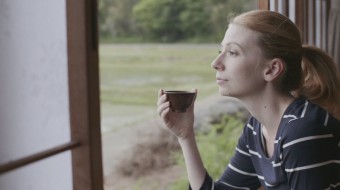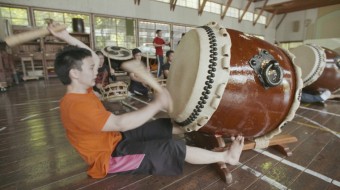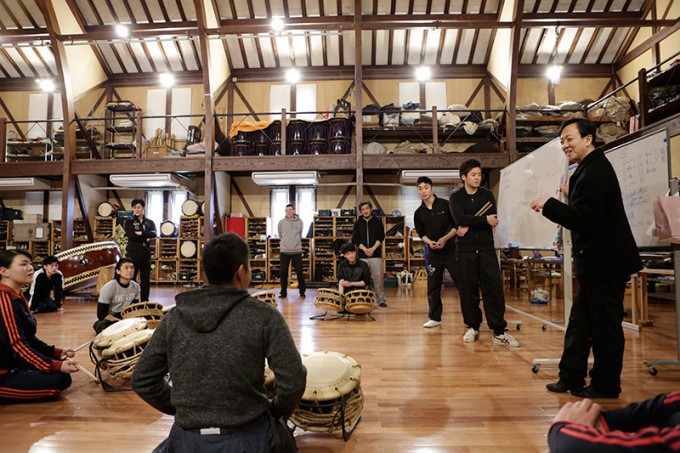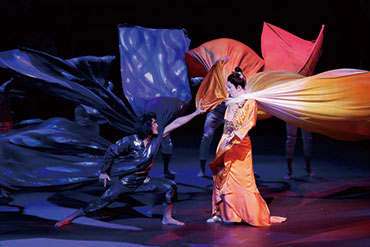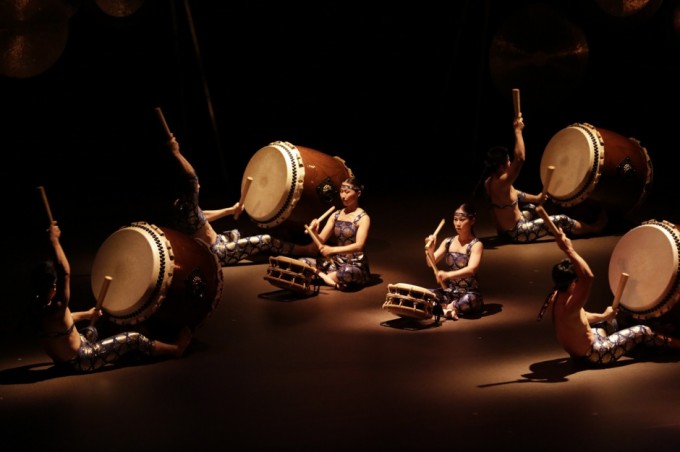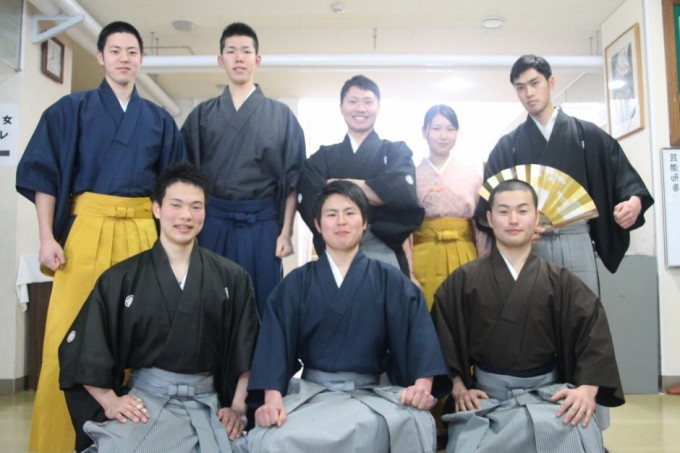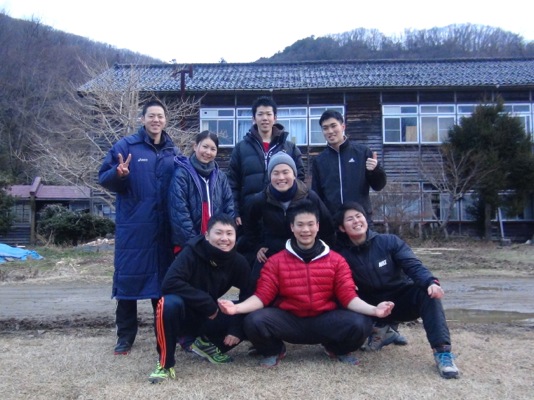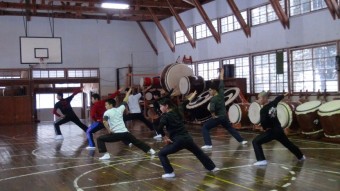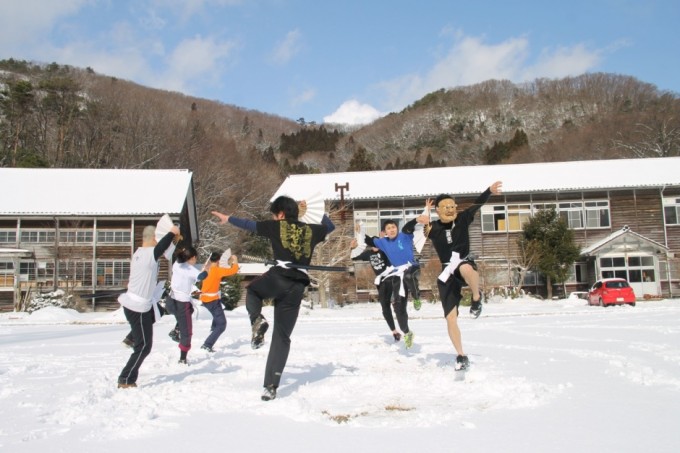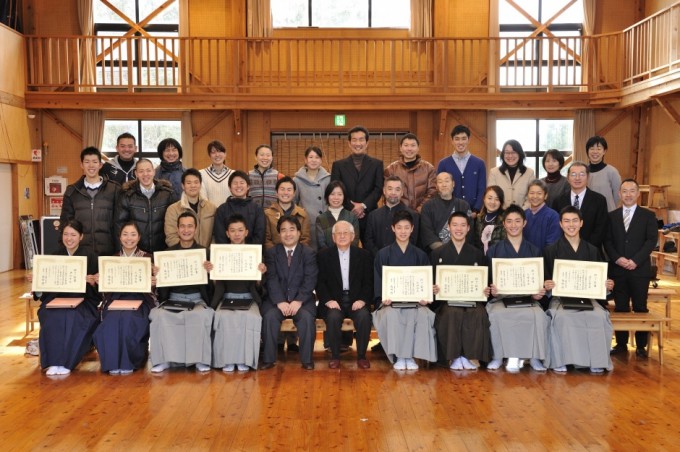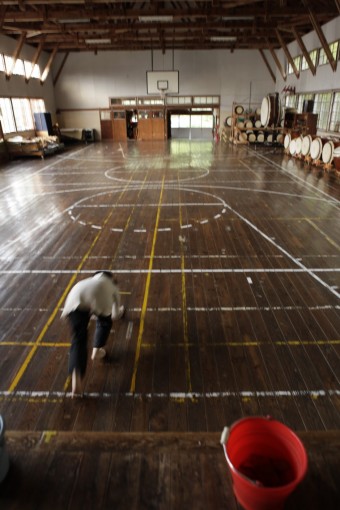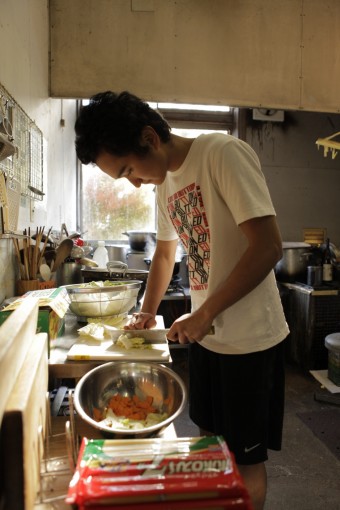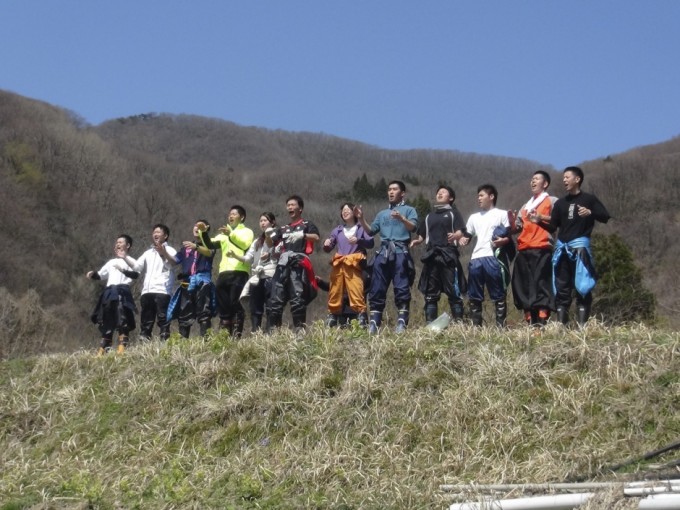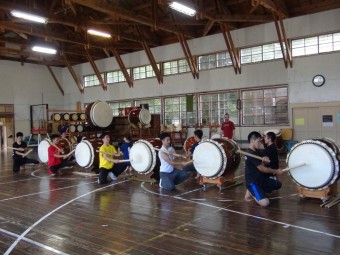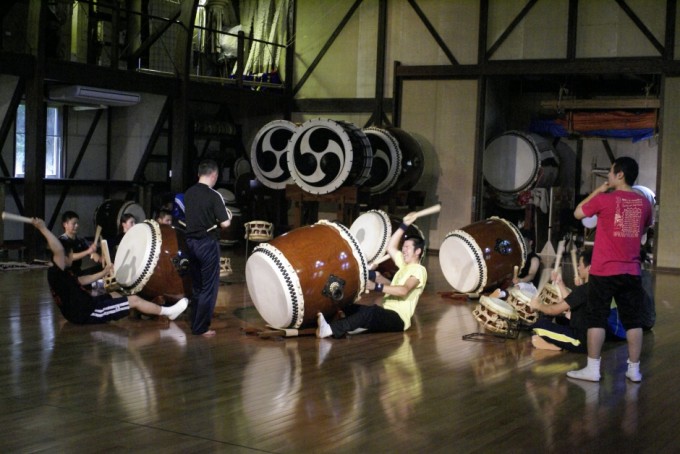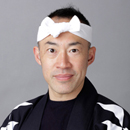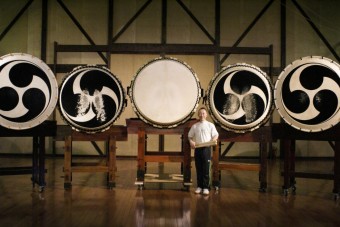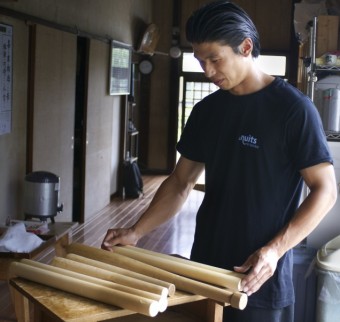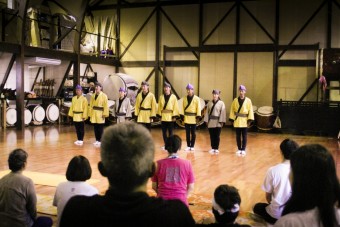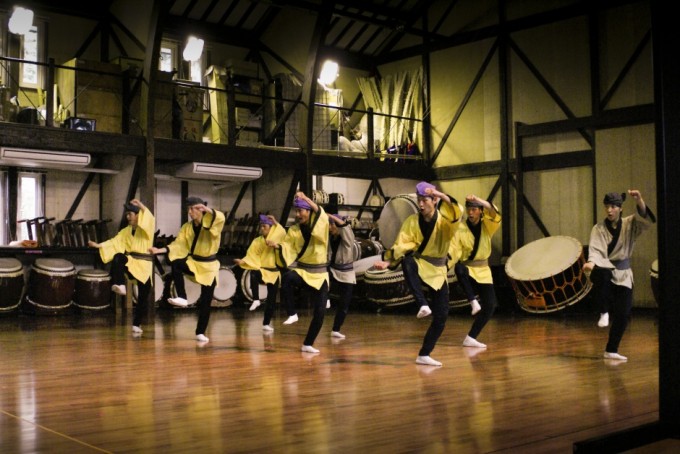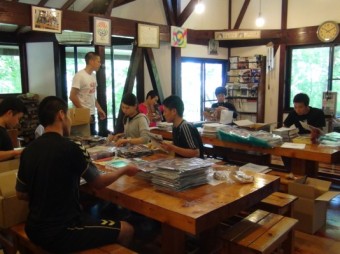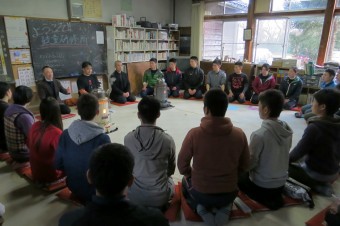Tag ‘Kodo Apprentice Centre’
TV Program “Journeys in Japan” On Demand
June 23, 2015
TV Program “Journeys in Japan” Featuring Kodo Apprentice Centre Available On Demand
“Journeys in Japan” is an English-language TV program that features foreign reporters traveling through Japan, showing the nation through their eyes. The latest episode is a journey to Sado Island and features demon drumming (onidaiko) as well as a visit to the Kodo Apprentice Centre. The report includes the apprentices playing taiko and a look at their lifestyle at the Centre and on Sado. This program was broadcast in 130 countries and is currently available for viewing worldwide online for a limited time.
Program Name: Journeys in Japan
View On Demand via NHK World Website (available until mid-July 2015)
http://www3.nhk.or.jp/nhkworld/en/vod/journeys/20150623.html
Contemporary dancer Alessandra Lupi visits Sado Island to study the powerful Onidaiko demon dance. The traditional performing art is offered to the gods to pray for peace and abundant harvests. Alessandra also experiences the traditional lifestyle of the region. She stays in a charming inn converted from an old home, tries rice farming and meets apprentices of Kodo, the renowned drumming ensemble. During her journey, she comes to feel how closely the Onidaiko performing art is connected to the local way of life. On the last day of her journey, Alessandra is bestowed with an honor that is most unexpected…
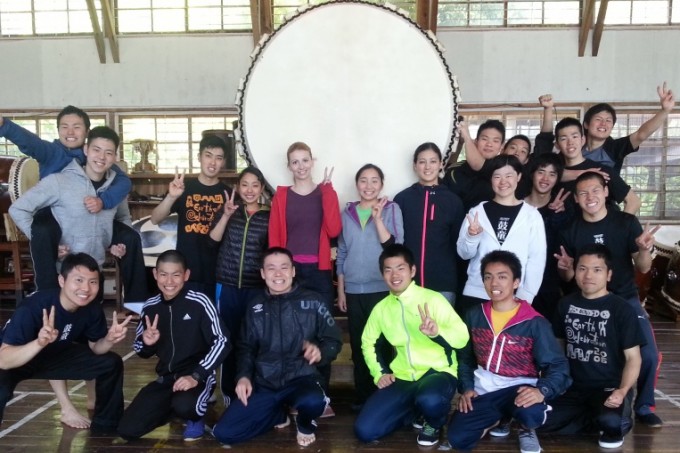
Kodo apprenctices with contemporary dancer Alessandra Lupi at the Kodo Apprentice Centre, Kakinoura, Sado Island.
“A Season of New Buds” by Tomohiro Mitome
May 1, 2015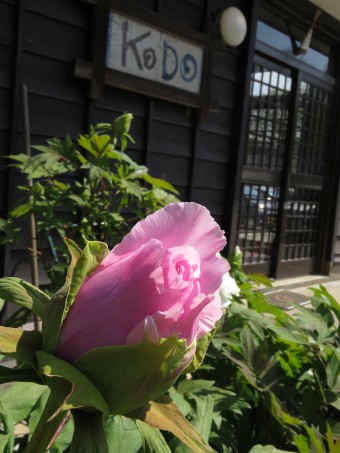
Hello, everyone! I hope that you are well.
This is Tomohiro Mitome, leader of taiko performing arts ensemble Kodo. May is here and it is a very comfortable, refreshing season. Flowers are bursting into full bloom and I feel so energized by spring.
As usual, April for Kodo was a time for us to hold rehearsals for the next new “Kodo One Earth Tour” production, which will premiere on Sado this November. We also rehearsed for “Kodo One Earth Tour: Eternity” and the School Workshop Performances, which resume their tours in Japan in June, as well as the “Kodo Special Performances on Sado Island,” and other projects. Much like the cycle of the nature, this is a season at Kodo when new buds emerge and grow.
This May, we will hold encore performances of “Amaterasu” at Shochiku-za Theatre in Osaka. “Amaterasu” premiered in 2006, and we also held popular encore seasons in 2007 and 2013.
This production is a rare opportunity for Kodo to collaborate on stage with our artistic director, Tamasaburo Bando. This year, we welcome back guest artist Harei Aine and look forward to sharing a new version of this performance with our audiences. In this production, we convey the story of a famous Japanese myth using the myriad sounds of Japanese musical instruments, ranging from raging gods, using the powerful roar of the taiko, to one scene where “eight million gods” gather for a party.
The party reaches its climax with a dance by a goddess called Ameno-uzume (performed by Harei Aine), which leads to the appearance of the dazzling sun goddess, Amaterasu, who emerges from the heavenly rock cave. That moment creates such a powerful wave of energy that even as performers on the same stage, we cannot help feeling moved by it as we play our taiko. It is a truly precious moment. I hope you won’t miss the opportunity to see this performance live!
“Kodo Apprentices Have a Go at Noh” by Yasuko Honma
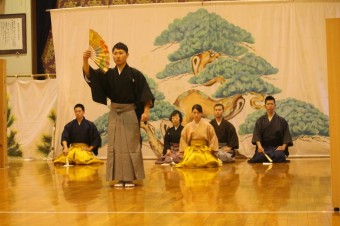
On March 1, the Kodo apprentices took part in a Noh recital in Hamochi on Sado Island. The Noh master who taught the Kodo apprentices until last year, Mr. Masao Matsunaga, stopped teaching because of his age, and a new master will come and teach our apprentices from later this year. So before this recital, some locals gave the apprentices three lessons and then they appeared on stage in their first Noh performance.
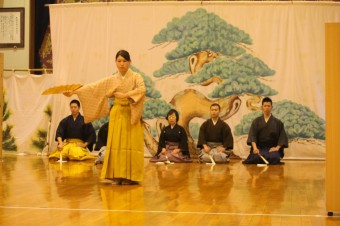
At the recital, they performed Shimai, one style of Noh where one person dances without a mask and the others sing along to accompany the dance. The title was “Momijigari”, which means “autumn-leaf viewing.” It was not easy to do the whole piece, but they did their best. Local students also joined in and the apprentices were very impressed by the Noh performances by high school students.
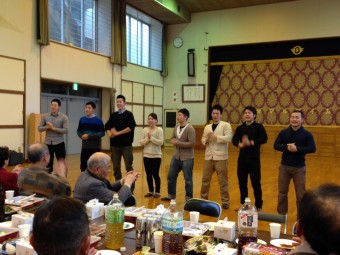
At the “Thank You” after-party, the apprentices enjoyed talking to a lot of different people. It was a valuable experience for them.
The locals say they look forward to the apprentices’ participation every year. They learned a lot about Noh, including dance and how to put on the various costumes, so they sang a song for them as a token of their gratitude .
“The Year 33 (2014-2015) Apprentices Commence Their 2nd Year” by Michiko Chida
Feb. 21, 2015
Year 33 class of Kodo Apprentices finished their 1st year of our programme in January and started their 2nd year in February. They used to rely on the apprentices in the year above for all kinds of things, but those senior apprentices have left the nest, so now there are just eight of them living here: 7 males and 1 female. The number of apprentices has halved, so they have to cooperate more than ever and figure out how to live together comfortably, as a new team. Otherwise, they will not be able to concentrate on their studies nor improve as a class.
On top of those changes, a powerful, relentless cold wave hit Sado during their transition period. It was the first winter on Sado for the new 2nd year apprentices, so they looked nervous to find out just how cold it would get. One night, when it was forecast to reach a low of -4℃ , one of the apprentices anxiously asked me:
“Is is going to get even colder?”
I said, “No, no, this is the coldest it gets on Sado. It won’t get any colder than this, so you can wear your warmest clothes now. You’ll be all right, you will survive!”
They had a dance practice day on one of those freezing cold days in February.
While teaching them Ohara-bushi, a Tsugaru dance from Aomori Prefecture in Northern Honshuu, Chieko Kojima looked outside and happily exclaimed, “Perfect! It really looks like Aomori!”
Yasuhiko Ishihara, the head of the Apprentice Centre, teaches them demon sword dance Onikenbai, which is a traditional performing art from Iwate Prefecture, also located in northern Japan. He told them, “The locals practice this dance outside at this time of year…”
The Year 33 apprentices must have become both physically and mentally stronger since last year…
I hope they will have grown even more by the time the new 1st year apprentices join them in April.
“Year 32 (2013-2014) Apprentice Graduation Ceremony” by Michiko Chida
Year 32 (2013-2014) Apprentice Graduation Ceremony (Jan. 17, 2015)
Eight members from the Year 32 (2013-2014) class graduated from the Kodo Apprentice Centre on January 17, 2015, having completed our 22-month-long apprentice programme.
When they entered the programme, there were 12 apprentices in their class, but 5 of them left after a year and the remaining 7 members advanced to the second year of the programme. In June 2014, an apprentice from the year above them, who took time off due to an injury, returned to continue his studies. The eight of them, with unique personalities that inspired each other, worked diligently to grow as individuals.
On this final day, they expressed their gratitude for all of the encounters & experiences made possible by their time at the Apprentice Centre. They ended their apprentice life with one last performance together, as a team, showing us their sense of unity.
Now, they will set off on different paths, but I hope that what they experienced here will become a foundation, source of confidence, and something that they will treasure for the rest of their lives.
Thank you very much to all of you who loved and encouraged these young apprentices over the past two years.
“Kodo Apprentices in Fall: Striving for a Place on Stage” by Tomohiro Mitome
This is Tomohiro Mitome, leader of taiko performing arts ensemble Kodo.
Now it is October and it has started to get chilly here on Sado Island.
“Kodo One Earth Tour: Mystery” and the “School Workshop Performance” tour are currently traveling around Japan. Some of you may have seen these performances already or will see one or both of them during these tours. Personally, I performed in the recent “Kodo Special Performances on Sado Island 2014: Autumn” series. Thank you very much to everyone who came along.
This month, I would like to talk about the apprentices studying at Kodo Apprentice Centre in hopes of becoming a member of the Kodo ensemble.
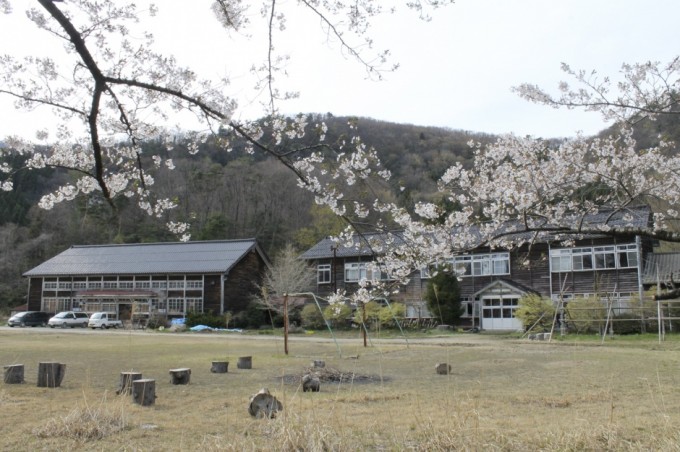
Kodo Apprentice Centre in Spring
To become a Kodo performer, first you need to complete a two-year apprenticeship at the Kodo Apprentice Centre (which includes passing selection to advance to the second year), and then on completion, you have to pass a final selection to join the Kodo ensemble. Those selected become “junior members” for approximately one year, during which they gain experience on stage and at a range of venues. After this probationary period, there is a further selection stage, which if they pass, they are offered a position as fully-fledged Kodo members.
At the Apprentice Centre, the apprentices get up at 5:00am in summer and 5:30am in winter, carry out cleaning duties, followed by stretching exercises and fitness training. After breakfast, they prepare the instruments required for the day’s practise and do warm-up exercises, then commence their morning practice. After lunch, they have afternoon practice, then after dinner, they practice either together or individually. They go to bed at 10:00pm in summer and 10:30pm in winter. This is their typical daily schedule. Sometimes, they come to Kodo Village, which is 40km away, to practice and do various tasks. On these days, they prepare a packed lunch to cut down on their meal time to accommodate the travel time.
At the Centre, the apprentices need to concentrate on the goal they are working towards, so we think they do not need the distraction of mobile phones and other electronic devices. Direct communication and connecting with people is a fundamental skill that should not rely on texting, email or the internet. Communication without email and texting is similar to the communication we need to have on stage. So that is why mobile phones and internet capable devices of any kind are prohibited during the apprenticeship. The apprentices are very busy practising everyday, except on their one day-off a week, and everyday they feel like they need more time to do everything they need to do. This means that even those of them who previously couldn’t live without mobile phones and computers easily get used to spending their time without them once they enter our intensive apprenticeship programme.
The first year apprentices started the programme in April, and now that about half a year has passed, at last they have gotten used to their new lifestyle and become “apprentice-like” to us. Currently, they are practising Yatai-bayashi and Miyake, which are both representative pieces of the Kodo repertoire, and they are getting to the stage where they can perform these pieces in full. As they work on their basic training, they also have been building up their physical and mental strength.
Basic training means repetition, and while it may not be interesting for them, this is a very important practice period to form their own individual base. If you don’t have solid foundations, when you try to build technique upon that base, it will just crumble away.
For example, the apprentices practise playing Yatai-bayashi for a long time, non-stop, because this piece requires physical strength to play in its entirety. If they don’t have enough power, the rhythm will become out of time, the sound will become weak, and it will be a really poor performance of the piece.
Now, it is very important for the first-year apprentices to do practise that will improve their physical strength, so they make themselves much stronger as they learn pieces and do their basic training repetitively. If you practise properly over and over, then technique will follow.
Meanwhile, the second-year apprentices are maintaining good physical strength, so now during their practice, we are helping them to improve their technique and instead of doing their best individually, we are instructing them to perform together as one powerful ensemble. We spend a lot of time teaching them in detail about making use of power, accents, and nuance in their playing. A good ensemble is created by each performer’s own skills.
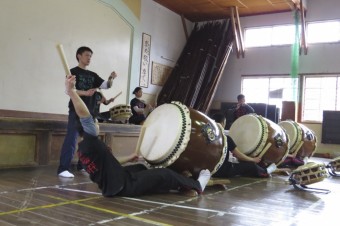
Only three months remain for second-year apprentices.
For them, each day is more important than ever before as they work towards their final recital in December, though there are also many fall events and harvest activities for them to fit in around concentrating on their practice. They all want to become Kodo members, so I hope that they will all come together as a team and do their best, without any regrets.
The first-year apprentices will also face selection to become second-year apprentices around the same time, so all the apprentices are nervous going into the three months ahead.
In Japan, there is a saying that it is not easy to improve one’s “mentality, technique and body.” I would like them to remember their hopes at the time when they first arrived at the Apprentice Centre, to imagine themselves standing on the Kodo stage, and to do their very best.
First Intake: Applications must arrive by Nov. 18 (Tue), 2014
*A limited second intake may be offered after the first intake.
“Valuable Lessons Performers Learn by Making Equipment” by Tomohiro Mitome
Sep. 1, 2014
This is Tomohiro Mitome, leader of taiko performing arts ensemble Kodo.
It is now September and little by little we can feel hints of autumn in the air. Actually, each year when the Ogi area falls quiet after the lively summer festivals, “Earth Celebration” and “Ogi Matsuri,” this calm feels like autumn has arrived all of a sudden.
This month, I would like to talk about my thoughts on making taiko drumsticks (bachi) and equipment.
I am constantly asked by taiko players, “Do you make your own drumsticks?” While it’s not every single pair, I do generally make my own drumsticks myself. This is connected to one of the core elements of Kodo’s Mission Statement: “Creating.”
When you become an apprentice and enter the Kodo Apprentice Centre, first you make your own chopsticks, then you make your own drumsticks. For the drumsticks, you use a saw to cut a square piece of timber to the right length, then using a plane you whittle the wood from a square piece into round sticks.
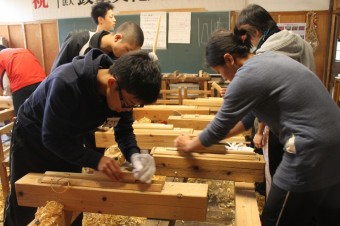
At first, you can’t make them well, but no matter how bumpy or oval your drumsticks are, they are filled with your blood, sweat and tears and you’ll be fond of them. And, it is a really huge shock when one of those drumsticks breaks. We really value them, so much so that we all keep our broken drumsticks for a special send-off, in the form of a lunar new year’s bonfire ritual each January.
Each pair of drumsticks is made from the same piece of wood, and if the sticks aren’t almost the same weight, the tone of the drum beats won’t be the same from your left and right hand. We are particular about our sound, so making drumsticks is very important to us.
In other words, for us, making drumsticks = making sound.
“Kodo Apprentice Recital: Okinawan Dance ‘Muribushi'” by Michiko Chida
Aug. 1, 2014
Kodo Apprentice Recital: Okinawan Dance Muribushi
The 2nd year apprentices spent one month learning Okinawan dance Muribushi, during this hot summer season. Today, they performed it for all the Kodo members and staff.
Okinawan dance expert Mitsue Kinjo has been teaching our apprentices for the last twenty years. By learning this unique, traditional Okinawan dance style, the apprentices are taught a fundamental attitude towards learning things. This is a timeless lesson.
“When you aim to create something new, first you have to take something in and absorb it within yourself. Then, something will be created from that. A new creation will come from something that takes root inside you and breathes. It is not something that you try to show or make decorative.”
Mitsue works hard with apprentices, actually, even harder than the apprentices, using her body and voice to passionately show and convey to them the importance of creating your own core.
I am sure that when the Kodo members, and the staff who were formerly apprentices, watch this annual recital that are reminded of their own time practicing as apprentices, frantically trying to use their bodies and minds well.
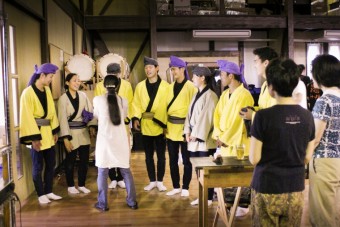
So, how were they today?
“Your hearts were all together, as one. You really did your best.”
After gruelling practices, Mitsue’s warm words echoed in the apprentices’ hearts. No one was selfish at all, and as individuals they all pulled together to perform together, which created such great power. Maybe today they understood the true meaning of Muribushi at last, which translates as “a group of stars.”
“Sending Out Kodo’s Monthly Newsletter” by Michiko Chida
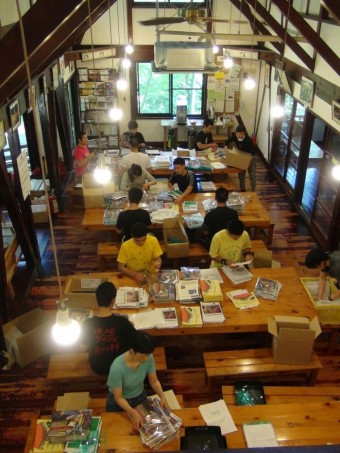
On the 10th of every month, the dining room at Kodo Village turns into a workspace as we prepare to send out the latest Monthly Japanese Newsletter “Kodo” to Kodo no Kai (Japanese Friends of Kodo service) members. The 1st-year Kodo apprentices always do this task, and this year they are joined by the new “Community Development Course” trainees. The envelopes are prepared by Kodo staff members and the apprentices insert the newsletter and flyers, seal them, count them for each region, and carry them to the front door to be picked up for shipping.
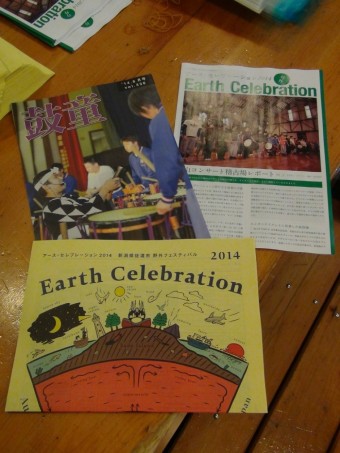
This month, we have sent out these 3 items. On the front page of the newsletter, you can see Kenta Nakagome leading a workshop during a “School Workshop Performance.” There are two other pamphlets: the Earth Celebration 2014 Programme and information about the guests for this year’s Shiroyama Concerts.
“The Start of a New Year” by Tomohiro Mitome
May 1, 2014
This is Tomohiro Mitome, leader of taiko performing arts ensemble Kodo. I would like to take this opportunity to say thank you to everyone who follows the Kodo website and Kodo Blog for your constant support of Kodo.
From now on, I am going to write a message at the beginning of each month to give you, our readers, an update from the Kodo ensemble. This month, I will talk about what I felt as we welcomed the new apprentices and junior members to the group recently.
Over the last few years, I have been energetically instructing our apprentices on Sado Island. On April 6th, I attended this year’s entrance ceremony at the Kodo Apprentice Centre.
The “Member Development Course” for people who want to become members of Kodo is a two-year course, with a diverse curriculum which includes performing arts, of course, and also studying agricultural work and etiquette, etc, which aims to develop well-rounded stage performers. When I was an apprentice, the apprentice program lasted one year and we did nothing but physical training and pounding in hours of taiko practise everyday… when I think about it, I feel like a long time has passed since then.
However, between then and now, the apprentices’ will to stand on the Kodo stage and to become Kodo members has not changed. When I see the sparkle in their eyes when we first meet at the entrance ceremony, every year it makes me remember my own initial resolve, and it always feels like the start of a new year.
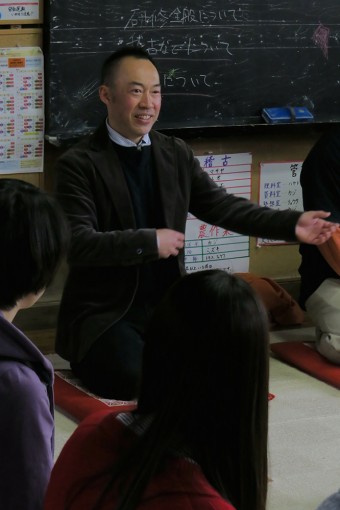
Apparently, many apprentices say that their lifestyle became the complete opposite of their former one when they entered the Apprentice Programme. The second-year apprentices, who have already spent a full year at the Apprentice Centre, welcomed the new first-years by saying, “Welcome to an unreal world!” and that really made an impression on me.
When I was a new to Kodo, one of the tour managers told me that a Kodo performance has both reality and unreality, and that showing the audience the unreal is what leads to making them dream and moving them. At the Apprentice Centre, where there is a mixture of reality and unreality, I hope that the apprentices will learn many things and gain a lot of experience during their two years, which will make them develop as performers. I hope that one day they can appear on the Kodo stage.
And now, having just completed this two-year-long Apprentice Centre lifestyle, the five young, new junior members are now mixed in with their seniors and they are frantically doing their best to prepare to take the Kodo stage.
Once we are on stage, it doesn’t matter whether you are a veteran or a newcomer, because as performers we are equal. While they have less technique and experience, the newcomers are armed with their youth. They have their own new sensibilities, and as musicians and performers I want them to do their best to create unforgettable performances for their audiences.




